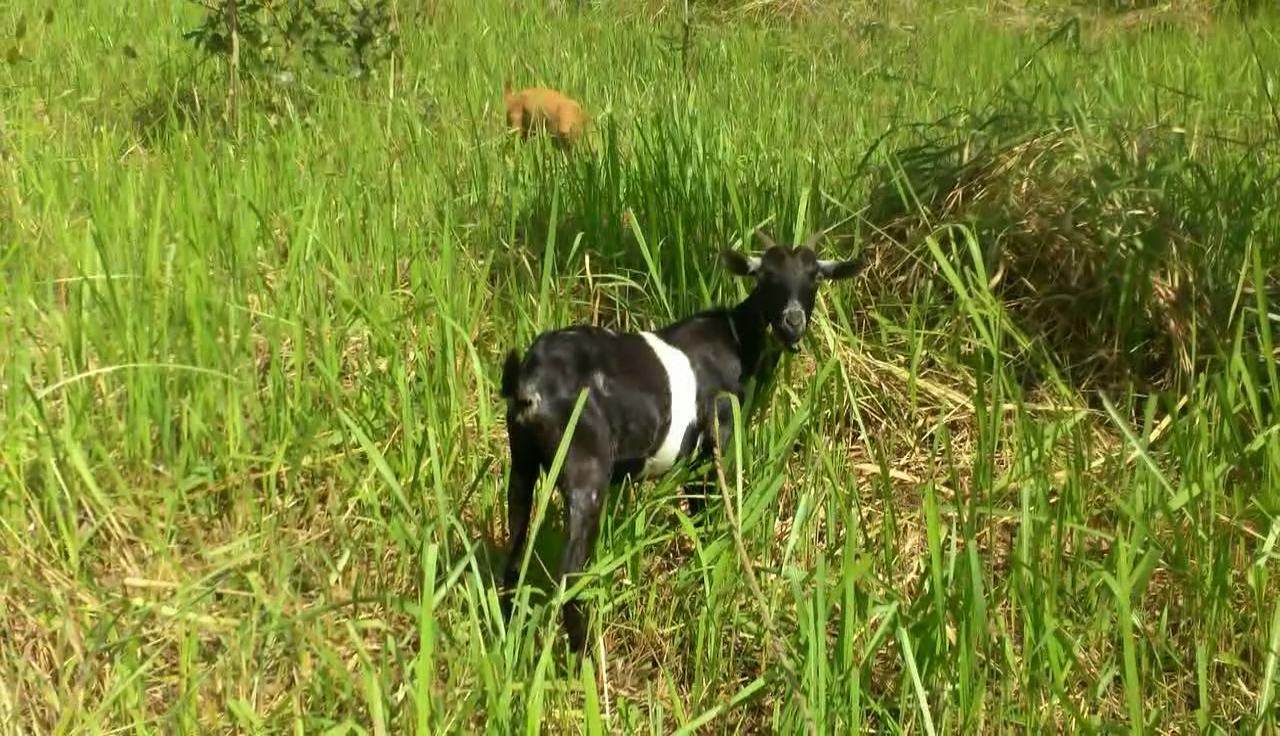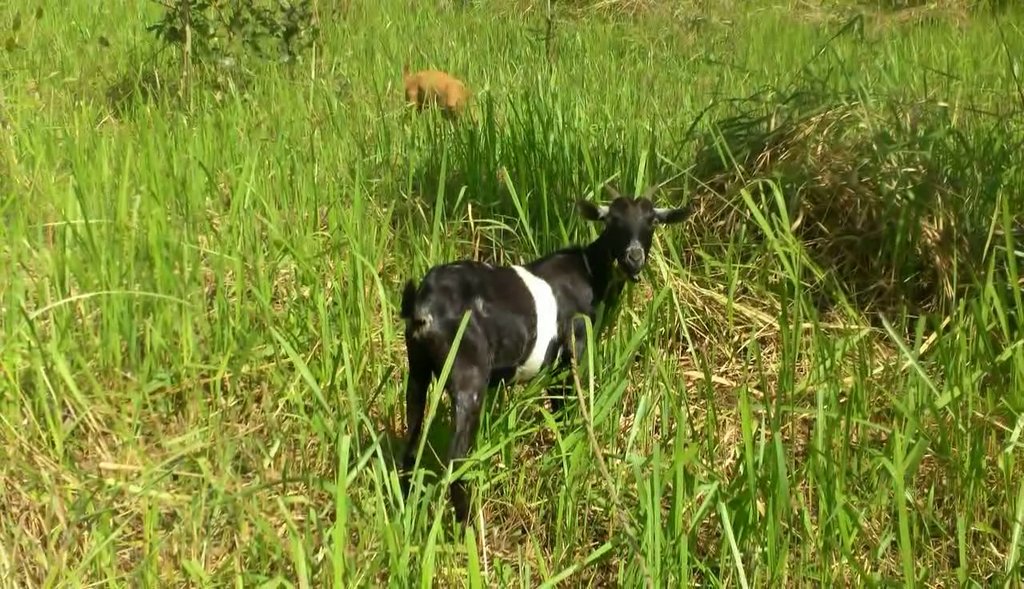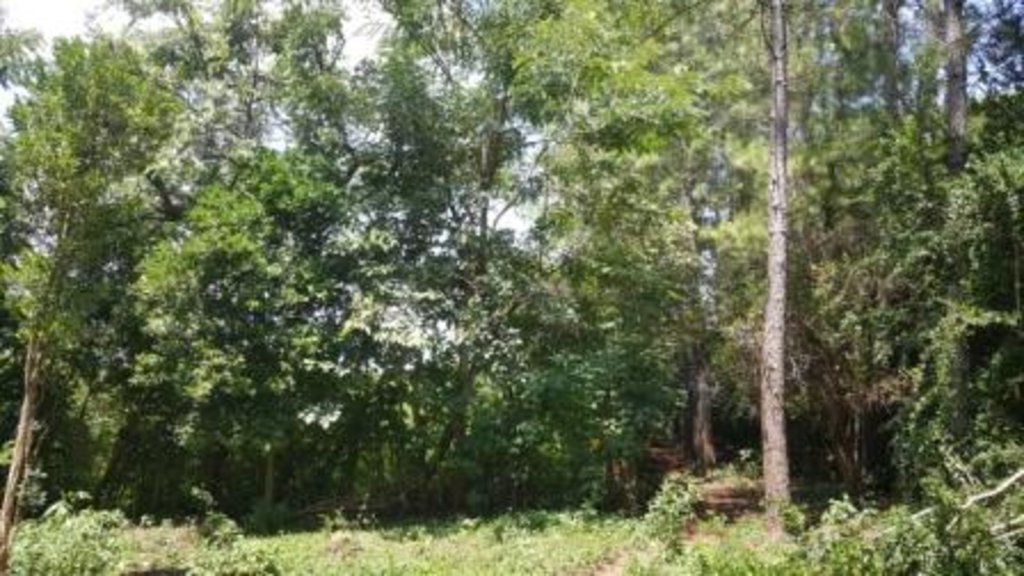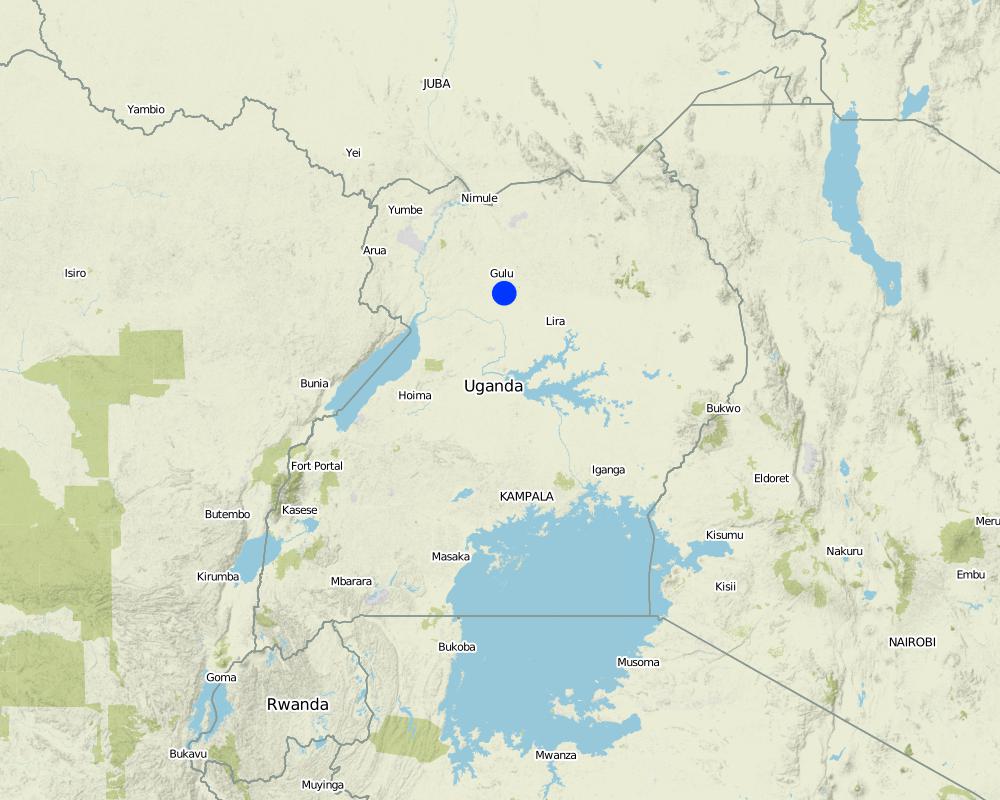Rotational grazing of goats for pasture conservation and improvement. [Uganda]
- Creation:
- Update:
- Compiler: betty adoch
- Editor: JOY TUKAHIRWA
- Reviewers: Drake Mubiru, Nicole Harari, Renate Fleiner, Stephanie Jaquet, Rima Mekdaschi Studer, Alexandra Gavilano
Gwoko Dyel
technologies_2147 - Uganda
View sections
Expand all Collapse all1. General information
1.2 Contact details of resource persons and institutions involved in the assessment and documentation of the Technology
Key resource person(s)
land user:
Mwaka Abel
Omoro district, Bobi subcounty, Paidwe parish, Pato village.
Uganda
1.3 Conditions regarding the use of data documented through WOCAT
The compiler and key resource person(s) accept the conditions regarding the use of data documented through WOCAT:
Yes
1.4 Declaration on sustainability of the described Technology
Is the Technology described here problematic with regard to land degradation, so that it cannot be declared a sustainable land management technology?
No
Comments:
Improves biodiversity in the grazing fields and improvement of soil fertility through rotational grazing where the goats wastes enhances soil fertility which enables the regeneration of natural pastures in the different paddocks.
2. Description of the SLM Technology
2.1 Short description of the Technology
Definition of the Technology:
Rotational grazing by improved goats variety enhances/ increases soil fertility, biodiversity and production of pastures and generates farmyard manure applied on cropland.
2.2 Detailed description of the Technology
Description:
Rotational grazing is the shifting of livestock to different units of a pasture or range in regular sequence to permit the recovery and regrowth of the pasture plants after grazing, which increased forage production. Forage that are over-grazed or are less healthy from being grazed every few days have smaller root mass, which leads to less soil organic matter. Northern Uganda has tropical savannah climate characterized by moderate rainfall of 750-1000mm per annum. This region also experiences prolonged dry spells from June to July and also November to March characterised by wild fire outbreaks which retards pasture growth. Because of this, land user has to conserve pastures through rotational grazing in a paddock system. The land is gently sloping with moderate soil humus that has also supported the growth of pastures. The land user is a subsistence farmer who graze goat in a paddock system for pasture conservations, manure generation for cropland, and goats for home consumptions and sale. About 90% of his income is from on farm activities.
A well-managed controlled grazing program can increase quality forage production by 30-70% each year. Much of this increase in forage production is accomplished by minimizing overgrazing. In this technology, six paddocks were created measuring 40x50meters on a five acres’ piece of land. Goats are shifted from one paddock to another in an interval of one month and later shifted to another section. The water tank is also moved as the goats are shifted to another paddocks. The shifting is to reduce on overgrazing. The land user has 40 goats. Two paddocks are grazed at the same time with each having a carrying capacity of 20goats to minimize on overcrowding and congestion at the water point. controlled grazing is practiced in order to protect the area from the damages of grazing that is digging up roots and everything in the field since this will de-grass an area and make it susceptible for erosion. By limiting graze time, fields can produce all year round instead of being a one-time harvest. Goats are not allowed to graze a paddock until it is at least 10 to 12 inches in height. If grazed any shorter, this compromises root recovery, energy storage in the roots, and grass' ability to depend on photosynthesis alone. This is why the land user preferred rotational grazing to prevent overgrazing, and allow the forage plenty of time to recover.
The inputs needed for the establishment of this technology are pangas, hand hoes, slashers, poles, and labour force to carry out the work of paddock constructions. To main the technology, the over grown grass is slashed to a height of 10 to 12 inches in height which is consumable by goats, water point is cleaned every two weeks to avoid contamination, paddocks repaired and goats constantly checked for treatment
The technology provides beneficial impacts like improvement of organic matter content and pasture soil fertility as a result of spreading manure around the whole pasture while grazing and browsing. Grazing goats typically return to the water tanks or a single favourite shade tree. The manure deposited around water tanks/tree shade is collected and used as farmyard manure for the seasonal crop production like cereals, vegetables, and legumes.
The technology is disliked because it is tedious to look after so many goats, wild animal attacks and drought affects water supply and pasture growth for the goats.
2.3 Photos of the Technology
2.4 Videos of the Technology
Comments, short description:
Goats grazing in the natural pastures
Date:
28/04/2017
Location:
Omoro District, Bobi Sub County, Paidwe Parish, Pato Village.
Name of videographer:
Betty Adoch
2.5 Country/ region/ locations where the Technology has been applied and which are covered by this assessment
Country:
Uganda
Region/ State/ Province:
Northern Uganda.
Further specification of location:
Omoro District.
Specify the spread of the Technology:
- evenly spread over an area
If precise area is not known, indicate approximate area covered:
- 0.1-1 km2
Comments:
The GPS point shows the land user grazing ground. Rotational grazing.
Map
×2.6 Date of implementation
Indicate year of implementation:
2003
If precise year is not known, indicate approximate date:
- 10-50 years ago
2.7 Introduction of the Technology
Specify how the Technology was introduced:
- through land users' innovation
Comments (type of project, etc.):
Diversify source of income, improve on nutrition and improve soil fertility.
3. Classification of the SLM Technology
3.1 Main purpose(s) of the Technology
- reduce, prevent, restore land degradation
- preserve/ improve biodiversity
- adapt to climate change/ extremes and its impacts
- mitigate climate change and its impacts
- create beneficial economic impact
- create beneficial social impact
3.2 Current land use type(s) where the Technology is applied

Cropland
- Annual cropping
Annual cropping - Specify crops:
- cereals - maize
- cereals - sorghum
- simsim
Number of growing seasons per year:
- 2
Specify:
Rainfall is moderate which sustains pasture growth.

Grazing land
Intensive grazing/ fodder production:
- Improved pastures
- Rotational grazing
Animal type:
- cattle - non-dairy beef
- goats
- poultry
- The goats graze the paddocks twice a year.
Species:
cattle - non-dairy beef
Count:
8
Species:
goats
Count:
40
Species:
poultry
Count:
50
Comments:
conservation of pastures
3.4 Water supply
Water supply for the land on which the Technology is applied:
- rainfed
Comments:
Rainfall is moderate which sustains pasture growth.
3.5 SLM group to which the Technology belongs
- rotational systems (crop rotation, fallows, shifting cultivation)
- integrated crop-livestock management
3.6 SLM measures comprising the Technology

agronomic measures
- A1: Vegetation/ soil cover
- A2: Organic matter/ soil fertility

management measures
- M1: Change of land use type
- M2: Change of management/ intensity level
- M3: Layout according to natural and human environment

other measures
Comments:
The mixed cropland is easily managed with livestock which provides manures to the cropland leading to high crop yields and pasture conservation.
3.7 Main types of land degradation addressed by the Technology

soil erosion by water
- Wt: loss of topsoil/ surface erosion

physical soil deterioration
- Pc: compaction

biological degradation
- Bc: reduction of vegetation cover
- Bs: quality and species composition/ diversity decline
Comments:
high risks of fire outbreaks and prolonged dry spells.
3.8 Prevention, reduction, or restoration of land degradation
Specify the goal of the Technology with regard to land degradation:
- prevent land degradation
- reduce land degradation
Comments:
To promote diversification and prevent land degradation.
4. Technical specifications, implementation activities, inputs, and costs
4.1 Technical drawing of the Technology
Technical specifications (related to technical drawing):
Five acres of land under paddock system of rotational grazing. The paddocks measures 40x50meter. Poles of about 1meter high are used to fenced the paddocks.
Author:
Betty Adoch
Date:
28/04/2017
4.2 General information regarding the calculation of inputs and costs
Specify how costs and inputs were calculated:
- per Technology area
Indicate size and area unit:
5acres
other/ national currency (specify):
UGX
If relevant, indicate exchange rate from USD to local currency (e.g. 1 USD = 79.9 Brazilian Real): 1 USD =:
3718.0
Indicate average wage cost of hired labour per day:
1000shs
4.3 Establishment activities
| Activity | Timing (season) | |
|---|---|---|
| 1. | Clearning the bush through digging and slashing | Dry season. |
| 2. | Marking the paddocks and planting poles | Dry season |
| 3. | Fencing the area | Dry season |
| 4. | Installing the water tank | Dry season |
| 5. | Introducing the goats into the paddock | Rainy season |
Comments:
Easy to eastablish rotational grazing.
4.4 Costs and inputs needed for establishment
Comments:
The cost is manageable by the land user.
4.5 Maintenance/ recurrent activities
| Activity | Timing/ frequency | |
|---|---|---|
| 1. | Slashing the over grown grass | wet season |
| 2. | cleaning the water tank | wet and dry season |
| 3. | Refilling the water tank | wet and dry season |
| 4. | Repairing the paddock | Dry season |
| 5. | Creating firelines | dry season |
Comments:
The land user protects his farm from the danger of fire outbreaks and pests.
4.6 Costs and inputs needed for maintenance/ recurrent activities (per year)
Comments:
Record keeping is not done by the farmer.
4.7 Most important factors affecting the costs
Describe the most determinate factors affecting the costs:
The labour costs for fencing the paddocks, and the high costs of fencing materials.
5. Natural and human environment
5.1 Climate
Annual rainfall
- < 250 mm
- 251-500 mm
- 501-750 mm
- 751-1,000 mm
- 1,001-1,500 mm
- 1,501-2,000 mm
- 2,001-3,000 mm
- 3,001-4,000 mm
- > 4,000 mm
Specifications/ comments on rainfall:
The rainfall is moderate and unreliable.
Indicate the name of the reference meteorological station considered:
Gulu meterological station.
Agro-climatic zone
- sub-humid
Climate is suitable for pasture growth.
5.2 Topography
Slopes on average:
- flat (0-2%)
- gentle (3-5%)
- moderate (6-10%)
- rolling (11-15%)
- hilly (16-30%)
- steep (31-60%)
- very steep (>60%)
Landforms:
- plateau/plains
- ridges
- mountain slopes
- hill slopes
- footslopes
- valley floors
Altitudinal zone:
- 0-100 m a.s.l.
- 101-500 m a.s.l.
- 501-1,000 m a.s.l.
- 1,001-1,500 m a.s.l.
- 1,501-2,000 m a.s.l.
- 2,001-2,500 m a.s.l.
- 2,501-3,000 m a.s.l.
- 3,001-4,000 m a.s.l.
- > 4,000 m a.s.l.
Indicate if the Technology is specifically applied in:
- convex situations
Comments and further specifications on topography:
The landscape is generally gentle easy to practice rotational grazing.
5.3 Soils
Soil depth on average:
- very shallow (0-20 cm)
- shallow (21-50 cm)
- moderately deep (51-80 cm)
- deep (81-120 cm)
- very deep (> 120 cm)
Soil texture (topsoil):
- medium (loamy, silty)
Soil texture (> 20 cm below surface):
- coarse/ light (sandy)
Topsoil organic matter:
- medium (1-3%)
5.4 Water availability and quality
Ground water table:
5-50 m
Availability of surface water:
good
Water quality (untreated):
good drinking water
Is water salinity a problem?
No
Is flooding of the area occurring?
No
Comments and further specifications on water quality and quantity:
suitable for human consuptions and animals .
5.5 Biodiversity
Species diversity:
- high
Comments and further specifications on biodiversity:
Different species of plants and animals coexist in the environment.
5.6 Characteristics of land users applying the Technology
Sedentary or nomadic:
- Sedentary
Market orientation of production system:
- mixed (subsistence/ commercial)
Off-farm income:
- less than 10% of all income
Relative level of wealth:
- average
Individuals or groups:
- individual/ household
Level of mechanization:
- animal traction
Gender:
- men
Age of land users:
- middle-aged
Indicate other relevant characteristics of the land users:
He totally depends on farming for livelihood.
5.7 Average area of land used by land users applying the Technology
- < 0.5 ha
- 0.5-1 ha
- 1-2 ha
- 2-5 ha
- 5-15 ha
- 15-50 ha
- 50-100 ha
- 100-500 ha
- 500-1,000 ha
- 1,000-10,000 ha
- > 10,000 ha
Is this considered small-, medium- or large-scale (referring to local context)?
- small-scale
5.8 Land ownership, land use rights, and water use rights
Land ownership:
- individual, titled
Land use rights:
- individual
Water use rights:
- communal (organized)
Comments:
The technologies secure the land from land grabbers within the community. The land user has full right over his land.
5.9 Access to services and infrastructure
health:
- poor
- moderate
- good
education:
- poor
- moderate
- good
technical assistance:
- poor
- moderate
- good
employment (e.g. off-farm):
- poor
- moderate
- good
markets:
- poor
- moderate
- good
energy:
- poor
- moderate
- good
roads and transport:
- poor
- moderate
- good
drinking water and sanitation:
- poor
- moderate
- good
financial services:
- poor
- moderate
- good
6. Impacts and concluding statements
6.1 On-site impacts the Technology has shown
Socio-economic impacts
Production
fodder production
Quantity before SLM:
negative
Quantity after SLM:
positive
Comments/ specify:
Due to conserved pastures.
Water availability and quality
drinking water availability
Quantity before SLM:
negative
Quantity after SLM:
positive
Comments/ specify:
Source of water is secured by the land user.
water availability for livestock
Quantity before SLM:
slightly negative
Quantity after SLM:
very positive
Comments/ specify:
Water filled in a tank for goats consumption.
water quality for livestock
Quantity before SLM:
negative
Quantity after SLM:
positive
Comments/ specify:
Goats fenced off which avoid water contamination.
Income and costs
farm income
Quantity before SLM:
negative
Quantity after SLM:
positive
Comments/ specify:
Rotational grazing has saved the land user from purchasing animal feeds which would be very expensive.
Socio-cultural impacts
SLM/ land degradation knowledge
Quantity before SLM:
negative
Quantity after SLM:
very positive
Comments/ specify:
Land user is aware of climate smart agriculture which has a lots of site benefits in terms of increased animal productions.
Ecological impacts
Water cycle/ runoff
evaporation
Quantity before SLM:
very positive
Quantity after SLM:
very negative
Comments/ specify:
Grass cover the soil from effects of evaporation.
Soil
soil moisture
Quantity before SLM:
negative
Quantity after SLM:
positive
Comments/ specify:
Grass covers the soil from erosion.
soil cover
Quantity before SLM:
slightly negative
Quantity after SLM:
very positive
Comments/ specify:
Grass covers the soil from being exposed to agents of erosion.
soil loss
Quantity before SLM:
very positive
Quantity after SLM:
very negative
Comments/ specify:
The grass covers the soil from erosion.
soil compaction
Quantity before SLM:
very positive
Quantity after SLM:
very negative
Comments/ specify:
Grazing goats loosen the soil particles which helps in fertile soil formation.
Biodiversity: vegetation, animals
biomass/ above ground C
Quantity before SLM:
negative
Quantity after SLM:
very positive
Comments/ specify:
Dry grass decompose to form humus.
plant diversity
Quantity before SLM:
negative
Quantity after SLM:
positive
Comments/ specify:
Different vegetation covers exist in the grazing fields.
Climate and disaster risk reduction
fire risk
Quantity before SLM:
very positive
Quantity after SLM:
very negative
Comments/ specify:
Fire lines are created during dry seasons to prevent wildfire spread to the grazing fields.
6.2 Off-site impacts the Technology has shown
buffering/ filtering capacity
Quantity before SLM:
negative
Quantity after SLM:
positive
Comments/ specify:
Grass roots filters and purifies the surface water.
damage on neighbours' fields
Quantity before SLM:
positive
Quantity after SLM:
negative
Comments/ specify:
Goats are fenced off from crop land reducing unnecessary destruction.
impact of greenhouse gases
Quantity before SLM:
high
Quantity after SLM:
low
Comments/ specify:
conserved vegetation acts as carbon sink
Specify assessment of off-site impacts (measurements):
The technology is highly sustainable.
6.3 Exposure and sensitivity of the Technology to gradual climate change and climate-related extremes/ disasters (as perceived by land users)
Comments:
The technology is sustainable.
6.4 Cost-benefit analysis
How do the benefits compare with the establishment costs (from land users’ perspective)?
Short-term returns:
slightly positive
Long-term returns:
positive
How do the benefits compare with the maintenance/ recurrent costs (from land users' perspective)?
Short-term returns:
slightly positive
Long-term returns:
positive
Comments:
The farmer has been able to generate income to improve his standard of living.
6.5 Adoption of the Technology
- 1-10%
Of all those who have adopted the Technology, how many did so spontaneously, i.e. without receiving any material incentives/ payments?
- 0-10%
Comments:
The technology has inspired many community members to engage in sustainable land management practices.
6.6 Adaptation
Has the Technology been modified recently to adapt to changing conditions?
Yes
If yes, indicate to which changing conditions it was adapted:
- climatic change/ extremes
Specify adaptation of the Technology (design, material/ species, etc.):
indegineous pastures are conserved for the goats.
6.7 Strengths/ advantages/ opportunities of the Technology
| Strengths/ advantages/ opportunities in the land user’s view |
|---|
| Conserve indegineous pastures. |
| The vegetation roots filters the surface water. |
| Strengths/ advantages/ opportunities in the compiler’s or other key resource person’s view |
|---|
| Availability of pastures for the goats through out the year. |
| The paddocks protects the land from land wrangles. |
6.8 Weaknesses/ disadvantages/ risks of the Technology and ways of overcoming them
| Weaknesses/ disadvantages/ risks in the land user’s view | How can they be overcome? |
|---|---|
| Limited capital to establish the paddocks. | Extenal support from doners. |
| Prolonged dry spells that retards pastures growth. | Practice climate smart agriculture like rotational grazing. |
| Weaknesses/ disadvantages/ risks in the compiler’s or other key resource person’s view | How can they be overcome? |
|---|---|
| Limited labour force to look after the goats. | Employing farm workers. |
| Pests and diseases that disturb the goats. | Technical services from the extension workers. |
7. References and links
7.1 Methods/ sources of information
- field visits, field surveys
one
When were the data compiled (in the field)?
28/04/2017
7.2 References to available publications
Title, author, year, ISBN:
Mixed crop-livestock farming - FAO
Available from where? Costs?
www.fao.org/docrep/004/Y0501E/y0501e03.htm
7.3 Links to relevant online information
Title/ description:
Mixed farming | ClimateTechWiki
URL:
www.climatetechwiki.org/content/mixed-farming
Links and modules
Expand all Collapse allLinks
No links
Modules
No modules





